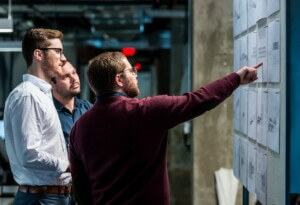In March 2021, Chicago architect and AIA member Josh Mings started a new job at Moody Nolan, that year’s AIA Firm Award recipient and the largest Black-owned architecture firm in the nation. He said he was handed deadlines requiring 60 to 80 hours of work a week, which became a drain on his mental health. “At the end of the day my brain was fried. There was no room for anything else,” said Mings. He resigned this past March after taking a leave of absence. “This profession eats its young whole,” he said. “There are many firms that treat employees as expendable.”
Asked by AN about Mings’s experience, Moody Nolan reiterated its belief in equitable and fair employment practices in accordance with U.S. Department of Labor guidelines. In a statement, the firm acknowledged that it “continues to adapt to changing economic tides, shifting our operational practices to accommodate work/ life realignment in the hybrid world.”
Mings felt that a union might have prevented this kind of burnout, and he’s hardly alone. In the wake of a high-profile union push by employees at SHoP Architects’ New York office (which ultimately failed) some AIA members are asking for the organization to take a pro-labor stand.
“The AIA has a moment right now to seize on this to make it the best possible for the most people,” said longtime member Donna Sink, of Indianapolis.
Sink and others pointed to historic new leadership in D.C. as a sign of progress. Lakisha Woods, AIA National’s first Black EVP/CEO, assumed her post at the end of January after Robert Ivy’s decade-long tenure. She confronts a workplace landscape where widespread dissatisfaction (generally described as the Great Resignation) has coincided with a union wave in the service and white-collar sectors. The idea that a creative field like architecture is a calling is losing support.
AIA members who agree with that sentiment want the organization to be more proactive in helping secure better working conditions and to adjust who’s served by its policies. Cleveland architect and AIA member Ted Ferringer said he wants the organization to take on a “worker perspective” and sees a “new consciousness of workers’ rights and workers’ issues” on the horizon. “I hope the AIA keeps up with the culture around that,” he said.
While there are historical precedents for architecture unions, many AIA members are unlikely to see themselves as workers. A 2020 survey released by the organization foregrounded the fragmented nature of the architecture industry. Of the 19,000 AIA member firms estimated to be responsible for two-thirds of all architecture services and revenue, a quarter are sole practitioners, and 60 percent have five employees or fewer, according to a 2020 survey released by the organization. At the same time, firms with 50 or more people account for more than half of the employment in private practice. (The average firm has 12 employees.) Only 37 percent of people working at architecture firms are women, and even fewer—32 percent—belong to ethnically diverse demographic groups.
The AIA has readily acknowledged this lack of gender and racial equity, as well as workplace bias. Still, the low pay and oppressive workloads that architects face make it hard for people without generational wealth or from precarious groups to stay in the profession. Ferringer framed the issue in class terms. “You can have great gender and racial diversity,” he said, “but if it’s still 95 percent people coming from upper-middle-class backgrounds, there’s still only a certain type of diversity happening.”
AIA member Gregory Walker, founder of Houser Walker Architecture in Atlanta and a one-time president of his local AIA chapter, is skeptical about unions in architecture. A business owner, he believes that the market is a better tool for disciplining firms that don’t offer reasonable work-life balance and benefits. “What I would hope is enough folks walk away from those firms and have the market say, ‘This is not a viable business model,’” he said.
Beyond unionization, AIA members said they want the organization to advocate for salary transparency, clear promotion schedules, pay equity, and improved leave benefits, which could be better tools to address workplace conditions at small firms where the ratio of bosses to workers is close to even. One tactic might be tying AIA awards to workplace conditions or executive compensation. “If you don’t pay your workers a living wage, you shouldn’t be in contention for an award,” said Sean Higgins, a Minneapolis architect and AIA member. “If your firm owner makes X amount above the lowest-paid worker, you should not be in contention for an award.” (The AIA already requires award recipients to pay interns.) Some would like to see the AIA Code of Ethics amended to create punitive regulations addressing work conditions.
AIA members also say that adjusting how leadership posts are assigned can bring about better workplace outcomes. For example, the AIA sets aside seats for students and associate members on its national board, so one option would be to set aside leadership posts for employees instead of business owners, who are already heavily represented in the highest echelons of the organization.
Sink, who is 55, said it’s important to bring young people into the organization’s leadership. “They are the ones experiencing the hurricane of issues right now—of not being able to afford housing, having good health insurance, or graduating with enormous debt and living paycheck to paycheck. We need people with that as their lived reality. I would pay higher AIA dues if it meant that younger members of the profession were getting a better life.”
AIA EVP/CEO Woods declined an interview with AN. She did, however, share a statement about the stressors that plague younger practitioners:
I have a great deal of empathy for architects and emerging professionals when they tell me they are struggling. Identifying and addressing the underlying issues we hear about from members—including salaries, hours, and bias in the workplace—is a critical step to ensuring the profession of architecture remains a force for positive change in society.
All of the AIA members AN spoke to identified the culture of architecture as a primary culprit in enforcing punishing workloads and meager pay, with many pointing out that these attitudes are often ingrained early. “We have a culture that starts in school, of ‘It’s never enough, you’re never done, you can always stay up late.’ There’s this fetishization of staying up all night,” said Marilyn Moedinger, founder of the two-person firm Runcible Studios in Boston.
But Higgins pointed to a deeper logic driving the industry: Cheap labor, either from long hours or from low pay, is profitable. “The intern, the worker, has really been used as a tool to gain profit for the firm owner,” he said. “The nature of that relationship can be abused.” Unionization is a tool to restructure this power imbalance and is a fundamental part of the critique of architectural practice offered by The Architecture Lobby, of which Higgins is a member. “What the Lobby’s trying to do is democratize the workplace,” he said.
Closer to home, he’s had support from within the AIA. He called Mary-Margaret Zindren, AIA Minnesota executive vice president, an “ally” in addressing labor conditions.
Zindren and AIA Minnesota haven’t taken a position on unionization, and she said it’s not something members are talking about with her. But those who are interested in unionization “are asking for the same things we’re saying architecture needs to provide,” she said. “There’s a lot of efficiency that’s been gained in architecture over the last few decades, and yet those efficiencies haven’t flowed back to change the expectations of the number of hours that are put in or haven’t materialized in benefit to workers.”
What AIA Minnesota has done is publicly state its aim to redefine practice along “authentic, equitable, and collaborative” lines. An important vehicle for this effort is the state chapter’s 70-plus-member Community of Practice for Culture Change committee, made up of everyone from architecture students to firm CEOs. These efforts predate the nascent union push at SHoP and include identifying mindsets that hinder or accelerate change. One mindset holding the committee back is that “long hours are a badge of honor and necessary to success in the profession,” said Zindren. “I see our role as supporting each individual member’s definition of success.”
A pivot to this sort of recognition at the national level needn’t be pitched as altruism, said Sink. When asked why she thought the AIA should focus on workplace conditions, she replied, “More members.”
Ferringer agreed. “The vast majority of members are employees,” he said. “Engagement [with the AIA] would significantly improve if worker-members felt that they were members of an organization that was advocating for them. You would hear a lot less of ‘Yeah, I’m an AIA member, but what do they do for me?’”
For Lora Teagarden, a member of the AIA Strategic Council, which advises the AIA National Board, it’s a matter of talent retention. “We’re losing quality minds to other professions,” she said. “We have to be able to protect our own. We have to be able to advocate for better lives outside of work as well as in work.”
Because the AIA is composed of both firms and individual members, it has many incentives to avoid a pitched fight between capital and labor. But how long can it be avoided, and what are the consequences of delay? Mings, the Chicago architect who left Moody Nolan and has since joined another firm, said that activism in the junior ranks is shortening this time line. “What’s great about the generation coming up behind me is that they are really pushing back,” he said. “They want to have a voice. They want balance in their life, and not to see ‘architect’ as their whole identity.”
(Mings emphasized that his opinions are his alone and do not reflect AIA or AIA Chicago.)










